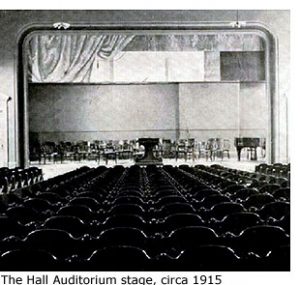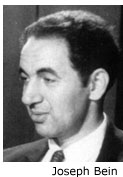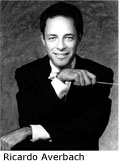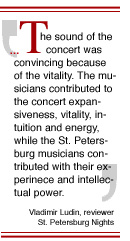Written by Mary Rebekah Ward Dicken and Ricardo Averbach
The First Years
The Miami University Orchestra dates back as far as 1890 to the Miami Stringed Orchestra, which consisted entirely of banjos, mandolin, guitars, and piccolo-banjos.
 It was not until 1903, however, that the Miami University Symphony Orchestra was officially founded. At its inception, this twelve-member ensemble, under the direction of Dr. S. S. Meyers, served to play each morning in the university chapel service and at most university functions. An article in the December 1904 edition of The Miami Student reads in part, “…since its organization a year ago, [the Miami orchestra] has perhaps contributed more to the pleasure of the college life of Miami than any other organization…” An editorial in the January 1905 Miami Student later boasts, “Both students and faculties can feel justly proud of our Orchestra. It is a living exemplification of the precept, that whatever is worth doing at all, is worth doing well…it would not be an exaggeration to say that it is the flower of the music department.” Soon after 1905, however, the orchestra was forced to disband as the number of instrumentalists at the university dwindled. Ten years later, in 1915, plans to revive the orchestra were undertaken. The Miami Student announced on November 25, 1915, “The development of the university orchestra is well under way, for the most difficult part of the process — that of securing the talent, was easily accomplished.” The premiere of this new ensemble took place on December 15, 1916, in the First Concert of the Miami University Orchestra with a 44-member ensemble held in Hall Auditorium under the direction of noted composer and conductor Joseph W. Clokey.
It was not until 1903, however, that the Miami University Symphony Orchestra was officially founded. At its inception, this twelve-member ensemble, under the direction of Dr. S. S. Meyers, served to play each morning in the university chapel service and at most university functions. An article in the December 1904 edition of The Miami Student reads in part, “…since its organization a year ago, [the Miami orchestra] has perhaps contributed more to the pleasure of the college life of Miami than any other organization…” An editorial in the January 1905 Miami Student later boasts, “Both students and faculties can feel justly proud of our Orchestra. It is a living exemplification of the precept, that whatever is worth doing at all, is worth doing well…it would not be an exaggeration to say that it is the flower of the music department.” Soon after 1905, however, the orchestra was forced to disband as the number of instrumentalists at the university dwindled. Ten years later, in 1915, plans to revive the orchestra were undertaken. The Miami Student announced on November 25, 1915, “The development of the university orchestra is well under way, for the most difficult part of the process — that of securing the talent, was easily accomplished.” The premiere of this new ensemble took place on December 15, 1916, in the First Concert of the Miami University Orchestra with a 44-member ensemble held in Hall Auditorium under the direction of noted composer and conductor Joseph W. Clokey.
Growing Up
 Over the next several decades, the orchestra’s leadership included conductors Donald Kissane, Roy A. Williams, Dr. Theodore Kratt, Gordon Sutherland, Joseph Bein, and Adon Foster. In 1957, the university secured conductor and composer Otto Frohlich, a native of Czechoslovakia, to direct the orchestra and the newly organized student opera program. Frohlich’s twelve year tenure with the orchestra contributed a great deal to the success of both the ensemble and the music department.
Over the next several decades, the orchestra’s leadership included conductors Donald Kissane, Roy A. Williams, Dr. Theodore Kratt, Gordon Sutherland, Joseph Bein, and Adon Foster. In 1957, the university secured conductor and composer Otto Frohlich, a native of Czechoslovakia, to direct the orchestra and the newly organized student opera program. Frohlich’s twelve year tenure with the orchestra contributed a great deal to the success of both the ensemble and the music department.
Into the Present
 After Frohlich’s retirement, the ensemble was directed by George Seltzer and later, Paul Nadler. Carmon DeLeone, current director of the acclaimed Cincinnati Ballet, served as director of the orchestra from 1980-1992. Following DeLeone were conductors Gary A. Speck, Jacob Chi, and Jose Luis-Novo, who, in 1998, founded the Oxford Chamber Orchestra, out of a collaboration between music faculty and select students. According to Novo, “The main goal of this orchestra is to provide real-life performance situations for students with the sort of musical interaction with their teachers that cannot be duplicated in the studio setting.” Following Novo was interim conductor Jaime Morales-Matos. In the fall of 2002, Ricardo Averbach, a native of Brazil, was appointed as conductor of the Miami University Symphony Orchestra, a position that he occupies until today.
After Frohlich’s retirement, the ensemble was directed by George Seltzer and later, Paul Nadler. Carmon DeLeone, current director of the acclaimed Cincinnati Ballet, served as director of the orchestra from 1980-1992. Following DeLeone were conductors Gary A. Speck, Jacob Chi, and Jose Luis-Novo, who, in 1998, founded the Oxford Chamber Orchestra, out of a collaboration between music faculty and select students. According to Novo, “The main goal of this orchestra is to provide real-life performance situations for students with the sort of musical interaction with their teachers that cannot be duplicated in the studio setting.” Following Novo was interim conductor Jaime Morales-Matos. In the fall of 2002, Ricardo Averbach, a native of Brazil, was appointed as conductor of the Miami University Symphony Orchestra, a position that he occupies until today.
International Stars
Both the Miami University Symphony Orchestra and the Oxford Chamber Orchestra have been privileged to host numerous world-class performing artists and composers in addition to talented faculty soloists.
Internationally recognized composer George Rochberg visited Miami’s campus in 1981 for the Symphony Orchestra’s performance of his Symphony No. 4. That same year, the orchestra hosted guest percussionist Michael Colgrass, who returned to campus nineteen years later as a visiting composer. In February 1999, William Preucil, concertmaster of the Cleveland Orchestra, performed Bruch’s Scottish Fantasy for Violin and Orchestra, Opus 46 with the Symphony Orchestra. Most recently, Constantine Orbelian, conductor of the Moscow Chamber Orchestra, conducted the Symphony Orchestra in their March 2004 performance of the music of Aram Kachaturian.
In February 2006 for the first time the symphony orchestra participated in a regular concert as part of the Performing Arts Series. The soloist was Haik Kazazyan, a young violin player laureate in several international competitions and a soloist of the Moscow Philharmonic. Other soloists followed, such as David Kim (concertmaster of the Philadelphia Orchestra), Bin Huang (winner of the Paganini International Competition), Efe Baltacigil (principal cellist of the Philadelphia Orchestra), Kun Dong (winner of the Yehudi Menuhin International Violin Competition), Ilya Finkelshteyn (principal cellist of the Cincinnati Symphony), the Brass Quintet from the Cincinnati Pops, and the renowned pianists Gleb Ivanov, Arnaldo Cohen and Yovcho Krushev.
Similarly, the Oxford Chamber Orchestra has benefited from collaborations with renowned guest artists. In October 2000, many of the university ensembles presented a millennium concert of award-winning composer Michael Colgrass’s music. In this concert, the Oxford Chamber Orchestra premiered Colgrass’s commissioned work Ghosts of Pangea. Earlier that year, the Chamber Orchestra accompanied clarinet virtuoso Richard Stoltzman, who performed the Clarinet Concerto by Mozart. In 2002, Yoon Lee, conductor of the Salzburg Symphony Orchestra, conducted the ensemble in its spring semester concert. In the Fall of 2004 The Oxford Chamber Orchestra participated in an acclaimed joint concert with the Moscow Chamber Orchestra. Other soloists appearing with the Oxford Chamber Orchestra were Zara Gulyeva (violin), James Strauss (flute), Lilia Donkova (violin) and several members of the Miami faculty.
Notable Concerts: National, International, and Local
In the past 40 years, the Miami University Symphony Orchestra has performed in many notable concerts including:
- 1980: Festival of Russian Music
- 1981: Inauguration of University President Paul G. Pearson
- 1984 and 1992: Ohio Music Educators Association conferences, and
- 1997: Inauguration of University President James Garland
- 2006: Inauguration of University President David Hodge
- 2015: gala concert of the 2015 College Orchestra Directors Association (CODA) International Conference
Opera
For over a decade the Miami University Symphony Orchestra has been the official orchestra of the opera program of the university, participating in multiple productions such as Mozart’s Le Nozze di Figaro, Cosi Fan Tutte and The Magic Flute, Britten’s Albert Herring, Bernstein’s Trouble in Tahiti, Puccini’s Gianni Schicchi, Offenbach’s La Perichole and many others. During the 2011-12 season, the Oxford Chamber Orchestra performed in the opera, being a key element in the award winning production of Cendrillon by Massenet, which received the 2nd prize at the National Opera Production Competition (Division IV).
Russia
 Under the direction of Ricardo Averbach, the Miami University Symphony Orchestra has been taken to a new level of artistic performance. During the summer of 2005 the orchestra went abroad for the first time, participating in the Russian-American Orchestra Institute. During the trip, Miami students performed side-by-side with students from the St. Petersburg State Conservatory Chamber Orchestra, receiving outstanding reviews. The performances took place in Symphony Hall in Novgorod and Glazunov Hall in St. Petersburg. The soloist was trombone professor Jaime Morales-Matos.
Under the direction of Ricardo Averbach, the Miami University Symphony Orchestra has been taken to a new level of artistic performance. During the summer of 2005 the orchestra went abroad for the first time, participating in the Russian-American Orchestra Institute. During the trip, Miami students performed side-by-side with students from the St. Petersburg State Conservatory Chamber Orchestra, receiving outstanding reviews. The performances took place in Symphony Hall in Novgorod and Glazunov Hall in St. Petersburg. The soloist was trombone professor Jaime Morales-Matos.Invitations through Juried Adjudicated Blind Selection
In 2006, for the first time, the Miami Orchestra was selected through blind audition tape to all the conferences in the country that include participation of college orchestras, as follows:
- ASTA (American String Teachers Association) with NSOE (National School Orchestra Association) 2006 National Conference. MUSO was the only college level orchestra invited
- 2006 OMEA North Coast Professional Conference. MUSO was one out of two college orchestras accepted
- the MENC National Conference in Salt Lake City. MUSO was one out of two college level orchestras accepted
In the same year, the orchestra was invited to be the official Ohio representative in the Mozart Orchestra Festival Celebration in Salzburg, Vienna and Prague, celebrating the 250th anniversary of the composer.
The Second Decade: Celebrating a Centennial of Excellence
Starting in 2009, there was a change in the Oxford Chamber Orchestra. During the fall semester, this ensemble started to perform the yearly opera production at Miami, being constituted only by students. In the second semester, the Oxford Chamber Orchestra continued to perform as it was originally conceived – an ensemble that combines faculty members performing side by side with the most talented students in the Department. It was this ensemble who participated in the award winning production of Massenet’s Cendrillon.
In 2010, the Miami University Symphony Orchestra was one of the eight finalists for the American Prize, a feat that was repeated in 2016, the year of the orchestra’s centennial. In 2010, the Oxford Chamber Orchestra received the 2nd Prize in the Collegiate Category, while Ricardo Averbach received the American Prize as the top conductor at the collegiate level. Miami University continues to be the only high education institution with two orchestras as finalists for the American Prize in the same year.
After hosting the 2011 CODA Multi-Regional Conference, which brought to Miami over 30 conductors from different parts of the country, The Miami University Symphony Orchestra hosted the first International Conference for CODA in 2015, which brought over 100 conductors from 18 different countries. In the meantime, the Oxford Chamber Orchestra participated as invited ensembles in the 2014 Conference of the College Orchestra Directors Association, performing at the Rock and Roll Hall of Fame.
Throughout the second decade of this century, the Miami University Symphony Orchestra has been more committed than ever to diversity and collaborations. The ensemble performed special concerts dedicated to Chinese New Year, and music from underrepresented countries, such as Azerbaijan and Bulgaria. Collaborations with Global Rhythms led to the first tour of selected members of our ensemble to India, and collaborations with the renowned Indian composer AR Rahman.
The ensemble has been a pioneer in the idealization of transdisciplinary projects, collaborating with programs as varied as the Confucius Institute, Havighurst Center, Department of Art, Interactive Media Studies, Film Studies, and many others. Such collaborations inspired the commitment of the Miami Orchestra towards innovation, through projects never attempted before by other orchestras. Those projects involved the use of breakthrough software for the synchronization of live music and film, the approach of painting as a performing art, the incorporation of non-traditional and exotic instruments into a symphony orchestra, and several other ideas. As a result, the ensemble received numerous awards from Student Affairs, such as Outstanding Fine Arts Organization, Outstanding Multi-Cultural Program, and others.
2016-2017: The Centennial Season
For the celebration of its centennial, the Miami University Symphony Orchestra honored a number of living composers, such as Samuel Adler, Arturo Márquez, Anthony DiLorenzo (with the Cincinnati Pops Brass Quintet) and John Harbison, while launching the centennial of Leonard Bernstein. The celebration culminated with the premiere of “Arcade Variations,” a special commission from Miami’s composer Per Bloland, which is based on the main themes of music for games. In the year of its centennial, MUSO was one of eight finalists for the American Prize, competing with much larger programs in the country. Ricardo Averbach received his second award as runner-up in the category of orchestra conductor.
Of particular note was the American premiere of works by the prominent Mexican composer Arturo Márquez, who came to Miami as part of an International exchange program sponsored by CODA and the IBERMUSICAS. Márquez conducted the Miami University Orchestra in his renowned Danzón No. 2, in a versino that included the participation of our university choirs conceived and composed by Ricardo Averbach. This is the only version available on YouTube of the composer conducting his most popular composition.
The Miami University Symphony Orchestra continues its trajectory of excellence by performing for the first time in Cincinnati Music Hall during the Spring of 2019. The program will feature the American premiere of Roger Davis’ Concerto in F for Piano and Orchestra, the “first rock piano concerto every written,” featuring Michael Chertock as the soloist.
